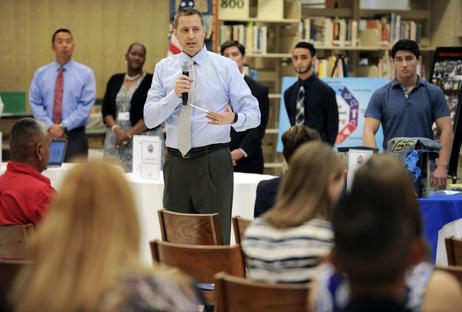Many public high schools are focused on preparing students for the rigors of a traditional, four-year college education. However, are other students, especially those interested in joining the workforce immediately upon graduation, being neglected in the process?
In recent years, funding issues and budget cuts have forced high schools to drop career-oriented elective courses. However, proponents of vocational education believe that the loss of these career programs has prompted many students to lose interest in high school in general.
Thankfully, there are public technical high schools throughout the country that specialize in vocational training – much to the delight of students who are interested in entering the workforce immediately upon receiving their high school diploma!
Vocational Programs: Preparation for the “Real World”
While most high schools offer on-campus vocational courses, some districts have collaborated to create district and county-wide vocational institutions. For example, , located in Upton, Massachusetts, gives high school students the opportunity to pursue an array of career-based courses, such as culinary arts, cosmetology, plumbing, healthcare, and dental assisting.
As Blackstone’s mission asserts, the high school is designed to foster “integrated academic and vocational technical skills, empowering each student to achieve world-class educational excellence, diverse career opportunities, and individual success in an ever-changing global society.”
There are, of course, similarities between Blackstone and the typical high school. Blackstone students must follow a core curriculum, such as math, history, and English, and they also enjoy participating in sports teams and clubs. However, the overall educational experience at Blackstone is significantly different from neighboring high schools.
Blackstone students can diversify their educational experience by opting to enroll in approved courses that reward teens with college credit. For example, the rigorous two-year Tech Prep program allows juniors and seniors to integrate academic learning with hands-on skills training. Students on this track spend two weeks engaging in various “on the job” cycles, working as trainees with employers from an array of trades and areas. In addition, since Blackstone allows students to choose from an array of focus areas within the Tech program, leaders of Blackstone “strongly encourage students to consider shop choices that are non-traditional for their gender, such as males in Health Technologies and Dental Assisting, or females in HVAC or Automotive Technology.” Indeed, Blackstone educators are challenging the conventional high school models of instruction, as well as the social status quo.
In fact, Blackstone is consistently creating solutions for problems facing our current world and future. Â鶹ąű¶ł´«Ă˝ly, Blackstone earned acclaims as the leading applicant for a fiscal grant from the Energy Solutions Accentuating Vocational Education (EnSAVE) foundation: “Recognizing the global need to seek alternative energies and educate staff and students in these new technologies, Blackstone Valley Regional Vocational Technical High School is one of six organizations named by Gov. Deval Patrick to receive a Clean Energy Workforce Development Grant.”
With this recognition and grant, EnSAVE aims to help Blackstone establish enhanced training for science weatherization, solar energy, and renewable energy educational opportunities. With these incredibly rare opportunities, participating students can earn training, certification, and credits towards innovative, in-demand tech industries.
Additional “Real World” Instruction
Adding to the admirable programs at Blackstone, (CCRT) is also recognized for its career-oriented curriculum pathways. Students attending CCRT are able to apply for educational courses in an array of fields:
- Auto collision and tech
- Carpentry
- Cosmetology
- Culinary arts
- Dental assistance
- Early childhood development
- Electrical
- Graphic arts
- Health technology
- Horticulture
- Hotel, business, and restaurant
- HVAC
- Information technologies
- Marine services
- Metal fabrication / welding
- Plumbing and heating
Each class limits the number of accepted students, ensuring that every participant receives in-depth, individualized training. Educators provide students with formal instructional courses, as well as hands-on laboratories and training opportunities.
Best of all, upon completing their program requirements, most graduates can secure employment immediately after high school. For example, in examining CCRT’s cosmetology program, leaders aim to teach students about the science, professional practices, and skills necessary for beauty care. Learning how to work with hair, skin, and nails, trained students practice in a real salon that’s open to public clients.
As students complete homework assignments, class lectures, hands-on work, as well as both written and performance evaluations, educators teach students the essentials for success in the field of cosmetology. According to the program, “Shop management and related business practices are stressed throughout the course, as shop management is often the ultimate goal of graduates. Students use professional salon management software, practice a variety of management skills, and employ a broad use of mathematics and other academic skills.”
Students above the age of 16, who have earned 1,000 hours of service and credits, are even eligible to take their state’s licensing exam. With a successful completion of the exam, students simultaneously earn their high school diploma and their cosmetology license!
While many high school students aspire to attend a four-year college institution, there are many others who are interested in delving into the workforce upon graduation. Indeed, vocational public high school programs provide invaluable skills for a myriad of industries, helping high school students fulfill their core education and career training simultaneously.












